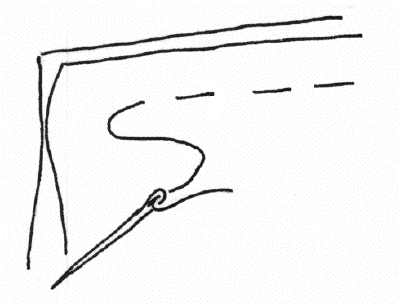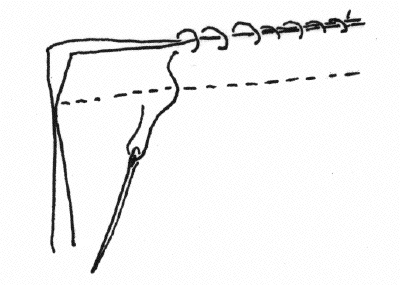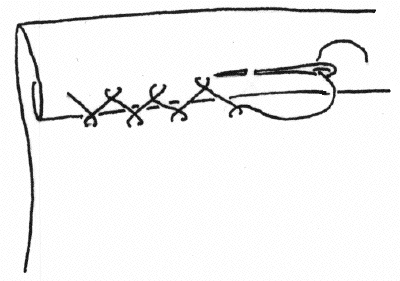
|
Running Stitch
Perhaps the simplest of stitches, the thread runs straight through the
fabric without doubling back on itself. Used to join fabric for
gathering and mending. |
Basting Stitch
Similar to a running stitch with very long stitches. Used as a flexible
alternative for pinning and for gathering, it can be pulled out easily. |
 |
 |
Back Stitch
A strong stitch, the back stitch is formed by pulling the needle
through the fabric, then doubling it back on itself. The needle emerges
beyond the stitch just made, and doubles back again for the
next
stitch.
|
Whip Stitch
A basic over-and-over stitch, can be used to form a hem or seam. |
 |
 |
Overcast Stitch
Basically, a whip stitch on the raw edge of fabric, used to finish the
edges
neatly and prevent fraying. |
Cross stitch
a.k.a. Catch stitch
Used to finish a hem or tack facings. The thread catches a thread or
two on the hem, then on the garment, crossing itself on each
half stitch. Creates a flexible hem with some give.
|
 |
 |
Button-hole Stitch
a.k.a Blanket Stitch
The thread passes under itself on each stitch (forming a half-hitch),
binding the edge of the fabric. If the threads are kept tight together,
it is a Button-hole stitch; if spaced out a bit (1/4" to 1/2"
apart) it is a Blanket stitch. |
Slipstitch
a.k.a. Blind Hem
A stitch that is almost invisible from the both sides. The needle
passes inside the fold of the hem, then emerges to catch one or two
threads, then back into the folded hem for the next stitch. |
 |
 |
Swing Tack
A stitch that connects two pieces of a garment while still allowing
movement between them. The thread is tacked to one piece of fabric,
then a chain knot is made with the thead, similar to a crochet chain.
The needle is passed through the last loop of the chain knot to lock
it, and that end is then tacked to the other piece of fabric. |
Vertical Hem Stitch
a.k.a. Couch Stitch
A stitch that is nearly invisible from the front side. The needle
catches two threads in the garment, then passes behind the folded hem
to emerge for the next stitch. It then rises vertically to catch two
threads in the garment for the next stitch |
 |









